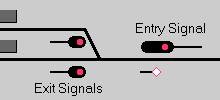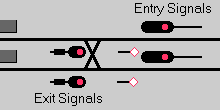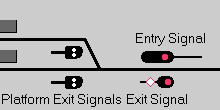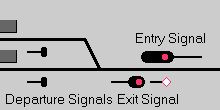Danish Signaling, Exit Signals (Private Lines)
Updated 990313

Contents
Introduction
Exit Signal Types
Exit Signal Aspects and Indications
"Stop" (Danish: "Stop")
"Proceed" (Danish: "Kør")
Exit Signal Useage
Location of Exit
Signals
Peculiarities

Introduction
Exit signals are found on almost all stations today. Their purpose is to
control the exit of trains from the station area and onto the line. This
document describes the Exit Signal as it is used on the Private Lines.
Exit Signal Types
Exit Signals on the Private Lines may be divided into two physical types,
a 2-lamp and a 3-lamp type as shown below. The 3-lamp type is the most
widespread today, and is used as a common signal for both tracks on 2-track
stations:


The exact physical design varies somewhat from line to line, but the
number of lamps and their use is standardized.
Exit Signals on the Private Lines never advance signal the following
Main Signal.
On junction stations, the 2-lamp Exit Signal type may be equipped with
a supplementary Route Destination Indicator of the special small type used
only on Private Lines:

Exit Signal Aspects and Indications
"Stop" (Danish: "Stop")
"Proceed" (Danish: "Kør")
|
 |
 |
 |
 |
-
Proceed at prescribed speed
|
X |
X |
X |
X |
-
Exit only permitted from the "Straight" track
|
|
|
X |
|
-
Exit only permitted from the "Diverging" track
|
|
|
|
X |
-
Train is routed towards the indicated destination
|
|
X |
|
|
Exit Signal Useage
The Private Lines feature a number of different usages of Exit Signals.
Below are shown the principles of these variations. It is not uncommon
for a station to have different signal equipment in the two ends of a station.
Location of Exit Signals
Common Exit Signal for both tracks
Most stations on the Private Lines are small single track stations with
a siding for meets. The most widespread signal configuration on these stations
today uses only one Exit Signal as a common signal for both signaled tracks.
The Exit Signal is usually located near the exit switch, of course visible
from both tracks:

The common Exit Signal is a 3-lamp signal, using the two "Proceed" aspects
to indicate which track, exit is permitted from:


Exit Signals at Platform Tracks
Some stations on the Private Lines conform to the practices of the Danish
State Railway Agency. The reason for this can be either that the visibility
of a common Exit Signal would be unacceptable, or that the railway prefers
the lower risk of misunderstandings in interpreting dual Exit Signals compared
to a common signal:



Exit Signals at junction stations
Common Exit Signals are never used at junction stations due to the obvious
risk of misinterpretation of indications (from which track to which line).
On some junction stations the Exit Signals are instead located at the end
of the platform tracks, and supplemented by a Route Destination Indicator:



Exit Signals with Platform Exit Signal
The combination of Platform Exit Signals and Exit Signal is used for one
of several reasons. One reason is if there is a need for local switching
at the station, as the Platform Exit Signal is capable of showing signal
aspects for switching or of being "canceled". Another reason for Platform
Exit Signals is visibility, similarly to the Exit Signal at Platform Track.
The Platform Exit Signal allows for duplication (repeater) signals to be
placed earlier in the platform track. Platform Exit Signals can also be
used at junction stations, similar to State Railway use.



Exit Signal with Departure Signal
Some older interlockings have used the Departure Signal to indicate departure
track while only providing a single Exit Signal:



Peculiarities
Sorry, no real peculiarities come to mind...


![]()
![]()
![]()

























![]()
![]()